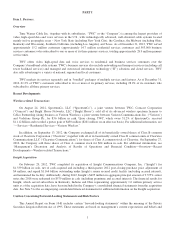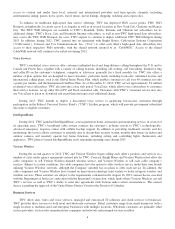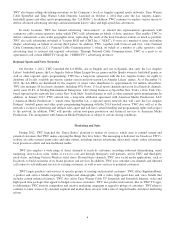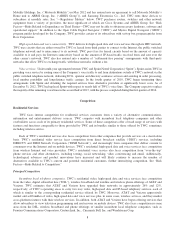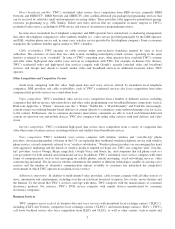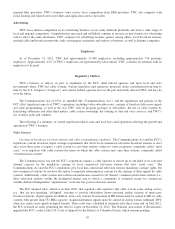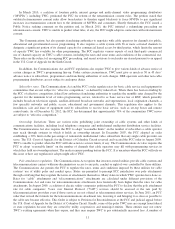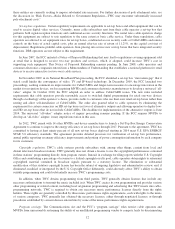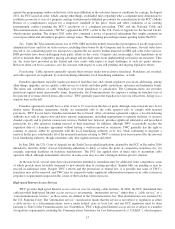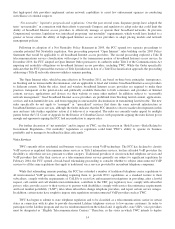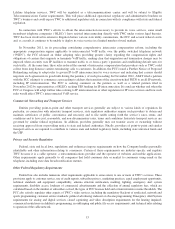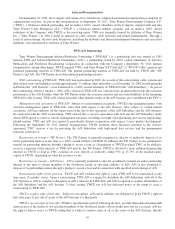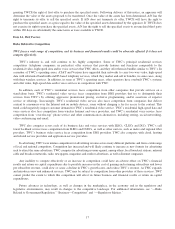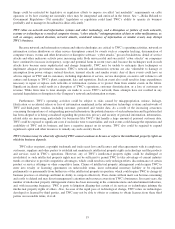Time Warner Cable 2012 Annual Report Download - page 20
Download and view the complete annual report
Please find page 20 of the 2012 Time Warner Cable annual report below. You can navigate through the pages in the report by either clicking on the pages listed below, or by using the keyword search tool below to find specific information within the annual report.regional fiber providers. TWC’s business video service faces competition from DBS providers. TWC also competes with
cloud, hosting and related service providers and application-service providers.
Advertising
TWC faces intense competition in its advertising business across many different platforms and from a wide range of
local and national competitors. Competition has increased and will likely continue to increase as new formats for advertising
seek to attract the same advertisers. TWC competes for advertising revenue against, among others, local broadcast stations,
national cable and broadcast networks, radio, newspapers, magazines and outdoor advertisers, as well as Internet companies.
Employees
As of December 31, 2012, TWC had approximately 51,000 employees, including approximately 750 part-time
employees. Approximately 4.2% of TWC’s employees are represented by labor unions. TWC considers its relations with its
employees to be good.
Regulatory Matters
TWC’s business is subject, in part, to regulation by the FCC, other federal agencies and most local and state
governments where TWC has cable systems. Various legislative and regulatory proposals under consideration from time to
time by the U.S. Congress (“Congress”) and various federal agencies have in the past materially affected TWC and may do
so in the future.
The Communications Act of 1934, as amended (the “Communications Act”), and the regulations and policies of the
FCC affect significant aspects of TWC’s operations, including video subscriber rates; carriage of broadcast television signals
and cable programming, as well as the way TWC sells its program packages to subscribers; the use of cable systems by
franchising authorities and other third parties; cable system ownership; the offering of data and voice services; and TWC’s
use of utility poles and conduits.
The following is a summary of current significant federal, state and local laws and regulations affecting the growth and
operation of TWC’s business.
Video Services
Carriage of broadcast television stations and other programming regulation. The Communications Act and the FCC’s
regulations contain broadcast signal carriage requirements that allow local commercial television broadcast stations to elect
once every three years to require a cable system to carry their stations, subject to some exceptions, commonly called “must
carry,” or to negotiate with cable systems the terms on which the cable systems may carry their stations, commonly called
“retransmission consent.”
The Communications Act and the FCC’s regulations require a cable operator to devote up to one-third of its activated
channel capacity for the mandatory carriage of local commercial television stations that elect “must carry.” The
Communications Act and the FCC’s regulations give local non-commercial television stations mandatory carriage rights, but
non-commercial stations do not have the option to negotiate retransmission consent for the carriage of their signals by cable
systems. Additionally, cable systems must obtain retransmission consent for all “distant” commercial television stations (i.e.,
those television stations outside the designated market area to which a community is assigned) except for commercial
satellite-delivered independent “superstations” and some low-power television stations.
The FCC adopted rules, effective in June 2009, that required cable operators that offer at least some analog service
(i.e., that are not operating “all-digital” systems) to provide subscribers down-converted analog versions of must-carry
broadcast stations’ digital signals. In addition, must-carry stations broadcasting in HD format must be carried in HD on cable
systems with greater than 552 MHz capacity; standard-definition signals must be carried in analog format (although TWC
often also carries such signals in digital format). These rules were scheduled to terminate after three years and, in June 2012,
the FCC released an order permitting the rules to expire on December 12, 2012. The National Association of Broadcasters
appealed the FCC’s order to the U.S. Court of Appeals for the District of Columbia Circuit, which remains pending.
10



